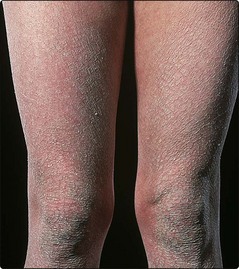Keratinization and blistering syndromes
Common skin disorders, e.g. atopic eczema or psoriasis, have a genetic component that is often subject to environmental influences. The genodermatoses differ in being single gene defects and include keratinization, blistering and neurocutaneous syndromes.
The ichthyoses
The ichthyoses are inherited disorders of keratinization and epidermal differentiation. They are characterized by dry scaly skin and vary from mild and asymptomatic to severe and incompatible with life (Table 1). Keratinization is abnormal. Some of the biochemical defects have been identified, e.g. steroid sulphatase is deficient in X-linked ichthyosis.
Table 1 A classification of the ichthyoses
| Disorder | Inheritance | Clinical features |
|---|---|---|
| Ichthyosis vulgaris | Autosomal dominant | Common (1 in 250). Onset 1–4 years. It occurs with atopic eczema. Often mild. Small bran-like scale seen. Flexures spared. Defect in filaggrin, needed for keratin assembly |
| X-linked ichthyosis | X-linked recessive | 1 in 2000 males. Generalized involvement with large brown scale. Onset in first week of life. Improves in summer. Due to a deficiency of steroid sulphatase |
| Non-bullous ichthyosiform erythroderma* | Autosomal recessive | Rare (1 in 300 000). At birth may present as collodion baby. Red scaly skin and ectropion may follow. Erythema improves with age |
| Bullous ichthyosiform erythroderma† | Autosomal dominant | Rare (<1 in 100 000). Redness and blisters occur after birth but fade. Warty rippled hyperkeratosis appears in childhood |
* Lamellar ichthyosis is similar but rarer.
† Also called epidermolytic hyperkeratosis.
Clinical presentation
Ichthyosis vulgaris is common and unrecognized if mild. Small branny scales are seen on the extensor aspects of the limbs and the back (Fig. 1). The flexures are often spared.
The other types of ichthyosis are uncommon or rare and can usually be identified by their clinical features, onset and inheritance. Autosomal dominant conditions tend to improve with age, whereas recessive ichthyoses may worsen. Collodion baby describes a newborn infant with a tight shiny skin that causes feeding problems and ectropion. It is mainly due to non-bullous ichthyosiform erythroderma. Acquired ichthyosis (p. 88) usually starts in adulthood.
Keratoderma
Keratoderma describes gross hyperkeratosis of the palms and soles, and may be acquired or inherited.




